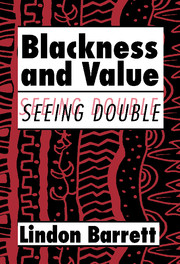Book contents
- Frontmatter
- Contents
- Acknowledgments
- Introduction: “In the Dark”
- Part One Violence and the Unsightly
- Part Two Reasonings and Reasonablenesses
- Part Three Phonic and Scopic Economies
- 5 Signs of Others: Circulations of a Purloined Letter Understood Otherwise
- 6 Signs of the Visible: (Re) Moving Pictures in The Narrows
- Notes
- Bibliography
- Index
5 - Signs of Others: Circulations of a Purloined Letter Understood Otherwise
Published online by Cambridge University Press: 18 December 2009
- Frontmatter
- Contents
- Acknowledgments
- Introduction: “In the Dark”
- Part One Violence and the Unsightly
- Part Two Reasonings and Reasonablenesses
- Part Three Phonic and Scopic Economies
- 5 Signs of Others: Circulations of a Purloined Letter Understood Otherwise
- 6 Signs of the Visible: (Re) Moving Pictures in The Narrows
- Notes
- Bibliography
- Index
Summary
In the post-1960s academy what comes to be known as poststructuralist theory radically redefines textuality and liberates critical discourse from the world of the formerly insular text, for, as theory would have it, “there is nothing outside of the text” (Derrida, Of Grammatology 158; emphasis in original). In other words, because “our very relation to ‘reality’ already functions like a text” (Johnson, “Introduction” xiv), textuality is taken to be a structure or condition far exceeding a limited set of hyperrealized linguistic events. The preeminent lines of New Critical reasoning and reasonableness are after the 1960s both greatly assailed and, for the most part, eclipsed by the unruly and amorphous entity known as poststructuralist theory. New Critical programs exert their primary influence on the post-1960s academy as the intuitive center of critical practice or, most openly, in the terms of nostalgia and loss. “Theory in the United States institution of the profession of English,” writes Gayatri Spivak, a paramount player in the ascendancy of deconstruction and poststructuralism in the United States, “is often shorthand for the general critique of humanism undertaken in France in the wake of the Second World War and then, in a double-take, further radicalized in the mid-sixties in the work of the so-called poststructuralists” (“Making” 788). Much more than formal exegesis, theory pursues
an analysis that focuses on the grounds of [any] system's possibility. The critique reads backwards from what seems natural, obvious, self-evident, or universal, in order to show that these things have their history, their reasons for being the way they are, their effects on what follows them, and that the starting point is not a (natural) given but a (cultural) construct, usually blind to itself.
(“Introduction” xv)- Type
- Chapter
- Information
- Blackness and ValueSeeing Double, pp. 185 - 213Publisher: Cambridge University PressPrint publication year: 1998



